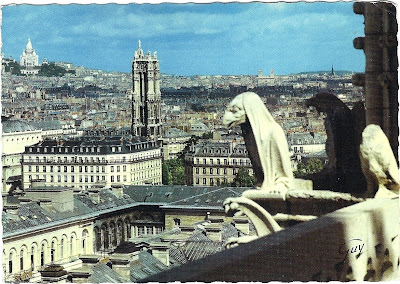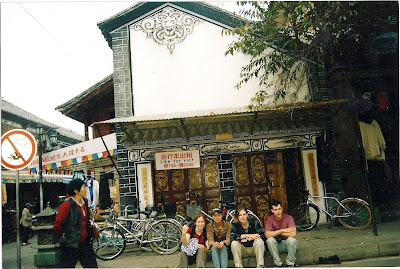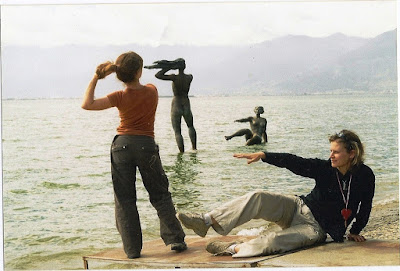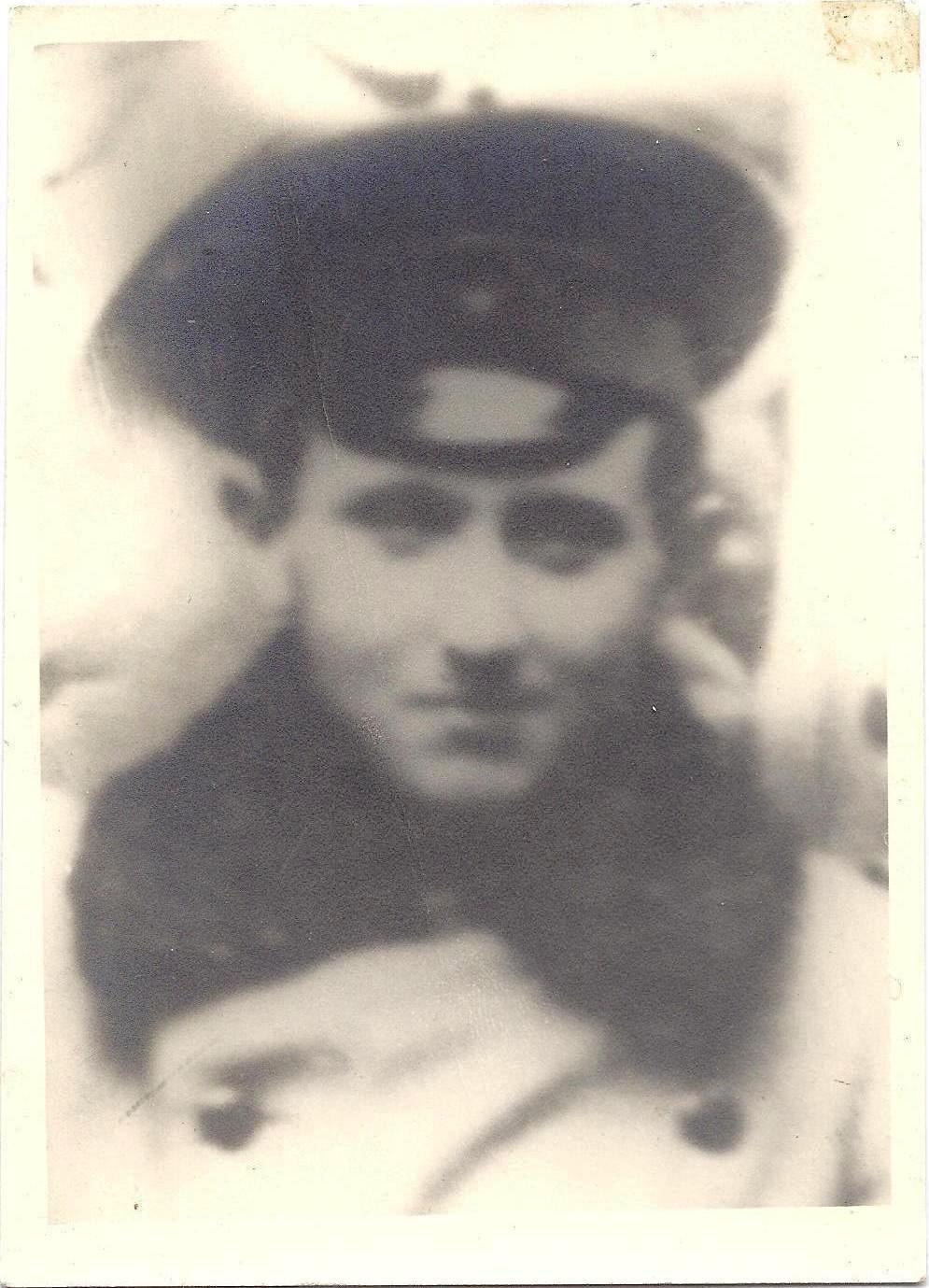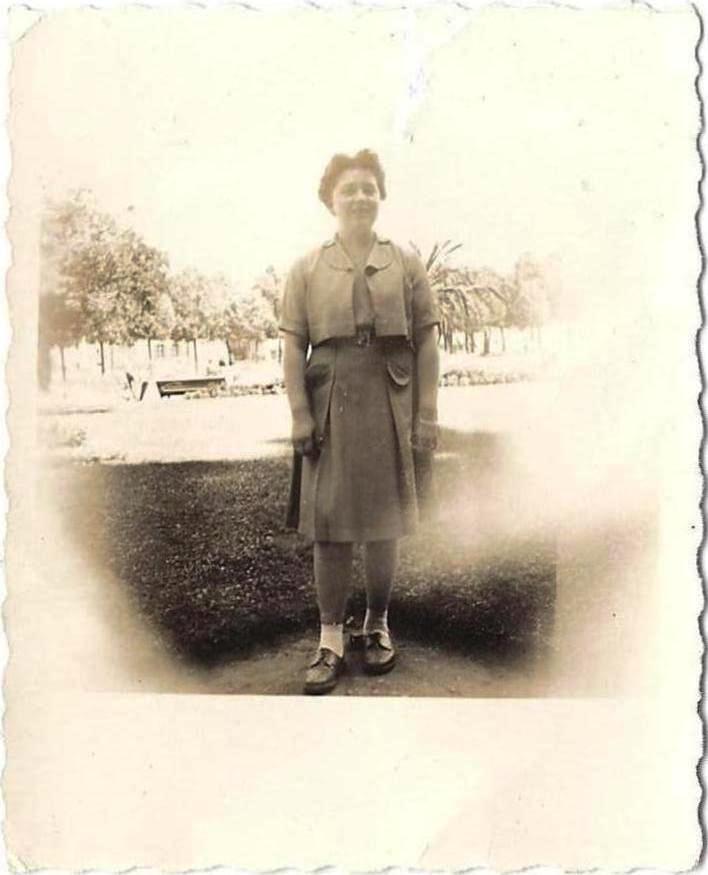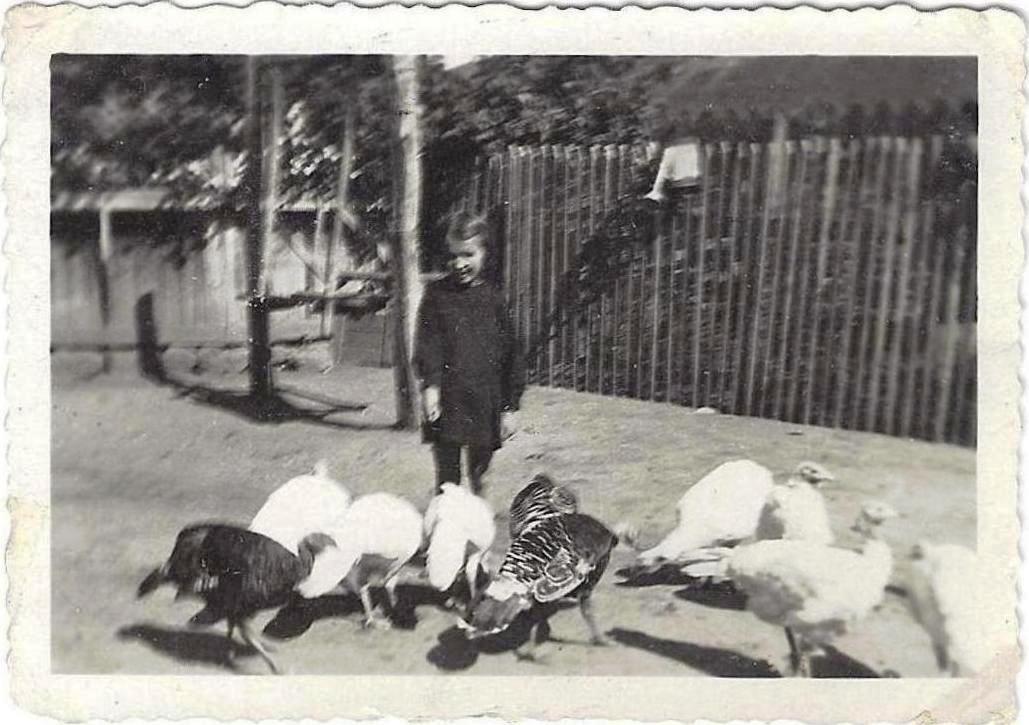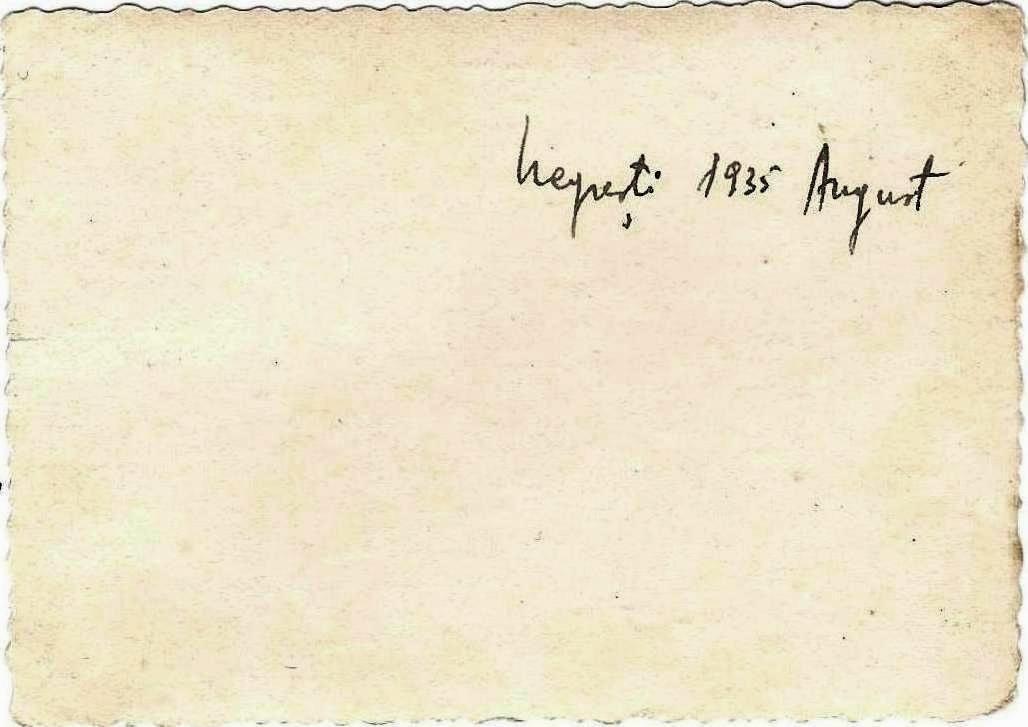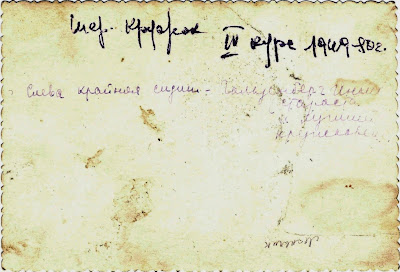הרשומה הזו מוקדשת לידידתי הציירת המגניבה והמאבק שלה בקומפוזיציות משעממות, כי לא מזמן יצא לי לקרוא משהו מעניין על קומפוזיציה בציור, אז חשבתי עליה, וגם על הגלויה הזו. ובעצם, זה משהו שאני באופן כללי אוהבת בגלויות - כשלא הולכים על התמונה התיירותית הסטנדרטית אלא בוחרים זווית (או קומפוזיציה) לא שגרתית. ולמיטב זכרוני, זו אכן היתה הסיבה העיקרית שבחרתי את הגלויה הזו, בגלל הגרוטסקות (לא גרגוילים!) האלה שיושבות לא בפוקוס בקדמת התמונה והופכות אותה פתאום למשהו הרבה יותר מעניין מסתם נוף עירוני פריזאי רגיל.
This post is dedicated to my awesome artist friend and her struggle against boring composition, because I recently happened to read an interesting thing about composition in painting, so I thought about her, and about this postcard. And really, this is something that I like in postcards, in general - when they don't go for the standard touristy photo but choose an unusual angle (or composition). And as far as I remember, this really was the reason I picked this card, because of these grotesques (they're not gargoyles!) sitting out of focus in the foreground, which suddenly make it into something much more interesting than a regular city view of Paris.
צד קדמי:
Front:
הגרוטסקות האלה שייכות כמובן לקתדרלת נוטרדאם-דה-פארי - ואני אומרת 'כמובן' לא כי אני כזו מומחית לפאריס אלא כי הפרטים מופיעים בצד האחורי של הגלויה. אבל תכל'ס, נוטרדאם (והגרוטסקות שלה) באמת נורא מפורסמת, ויכול להיות שהייתי מנחשת בעצמי. אגב, אם כבר אני מספקת פרטים לפי הכיתוב בצד האחורי, ברקע אפשר לראות את גבעת מונמארטר ובזיליקת הסקרה קר, את מגדל סן ז'אק, ואת כנסיית סן-ונסן-דה-פול. סה מניפיק!
בכל אופן, מכיוון שכבר הזכרתי את הצד האחורי, הגיע הזמן לראות מה נכתב שם.
בכל אופן, מכיוון שכבר הזכרתי את הצד האחורי, הגיע הזמן לראות מה נכתב שם.
These grotesques belong, of course, to the cathedral of Notre Dame de Paris - and I say 'of course' not because I'm much of a Paris expert, but because the details are written on the back. But to be honest, Notre Dame (and its grotesques) really is very famous, so I probably would've guessed it on my own, too. By the way, since I'm telling you details from the caption on the back, in the background you can see the Sacré-Cœur Basilica on Montmartre hill, the Saint-Jacques Tower, and the Church of Saint-Vincent-de-Paul. C'est magnifique!
Anyway, since I've mentioned the back, it's about time to see what's written there.
צד אחורי:
Back:
פאריס, 5/6/70
עידית החמודה!
אני כותב מגן ציבורי נחמד ליד ה-Concorde. בפריס אני עושה חיים נפלאים ואפילו נהנה מהקורס אליו נשלחתי. מה נשמע אצלך? איך החיים בירושלים. אנא, כתבי לי מכתב ארוך ומעניין על הנעשה בי-ם.
שלך: עמוס
Paris, 5/6/70
Idit sweetie!
I am writing from a nice park near the Concorde. I am having a wonderful time in Paris, and even enjoying the course I was sent to. How are you doing? How's life in Jerusalem. Please write me a long interesting letter about all that's going on in Jlm.
Yours: Amos
הבילושים שלי לא עזרו הרבה, הפעם. חשבתי שהשם עמוס סופר מוכר לי, אבל כנראה שהתבלבלתי, כי לא מצאתי אף אחד שנראה רלוונטי בין כל העמוס-סופר-ים שעלו בגוגל (ביניהם אחד עם פרצוף רציני שמתעסק במשהו עם מחשבים, אבל רק גמר ב"א בשנות השמונים אז לא נראה לי שהוא זה שביקר בפריס ב-1970, יקיר העיר נתיבות בתחום המסחר והתעשייה לשנת 2012, שב-1970 בדיוק פתח נגריה בנתיבות - לא מוזכר קורס בפאריס, ובכלל, מטון הגלויה נשמע שעמוס סופר 'שלי' התגורר בירושלים -ועוד כמה שנראים צעירים מדי ו/או בלתי קשורים בעליל. בקיצור, אין לי מושג). לעומת זאת, גוגל כן מצא לי את "פקידת הסעד הגב' עידית נתנאל, מנהלת התחנה לטיפול בחיי המשפחה ונישואין, אזור דרום ירושלים" שנשמעת כמו אופציה הגיונית למדי. באתר עיריית ירושלים אפילו מצאתי את כתובת הדוא"ל שלה, וניסיתי לכתוב לה ולשאול על הגלויה, אבל לא קיבלתי תשובה (אני יכולה לשער שהיא עסוקה למדי).
עדכון, 6.12.2012: כל כך מהר! איזה קוראים מגניבים יש לי. אחד מהם, יובל, קרא את השיחה בתגובות והחליט לעשות מעשה ולפנות לגיל חובב (שבילדותו - באותה התקופה בערך - גר גם הוא במבוא יורם, בבניין ממול) דרך האתר החדש שלו, FoodSpy (אגב, מסתבר שזה אתר כיפי ממש, שמזכיר את הימים הטובים של המדור[ים] של גיל חובב בעיתון, למי שמכיר והתגעגע). זו התשובה שקיבל:
שלום יובל,טוב, אז אני לא הולכת לבדוק את המשפחות מהקומה הראשונה (לא בזמן הקרוב, בכל אופן), אבל עדיין, איזה יופי!
עד כמה שזכור לי, עידית נתנאל אכן גרה בקומה האחרונה של מבוא יורם 7. אם זכרוני אינו מטעני (מדובר בלפני 40 שנה), היא הייתה רווקה ויפה.
אולי כדאי שתתעניין אצל משפחות גולן ושיינין שגרו בקומה הראשונה.
ברכות,
ג"ח
My detective work didn't do much good, this time. The name Amos Sofer sounded kinda familiar, but I guess I was wrong, because I couldn't find anyone that seemed relevant among all the Amos-Sofer-s that came up on Google (including one serious-looking dude who does something with computers, but only finished his BA in the 80s so I doubt he was the guy who went to Paris in 1970, one 2012 Patron of the City of Netivot in the field of trade and industry [Hebrew link, sorry!], who in 1970 just opened his carpentry shop in Netivot - no course in Paris is mentioned, and besides, from the tone of the postcard it sounds like 'my' Amos Sofer lived in Jerusalem - and a few others who looked too young and/or totally unrelated. I have no idea, is what I'm saying). On the other hand, Google did find a welfare officer named Idit Netanel, head of the Center for Marriage and Family Life [my translation, because I couldn't find the official term; if I'm wrong, please let me know] in south Jerusalem, which sounds like a pretty logical option. I even found an email address for her, in the Jerusalem Municipality website, and I tried writing her to ask about the postcard, but got no answer (I can imagine she's a busy lady).
Update, Dec 6 2012: So soon! My readers are really cool. One of them, Yuval, read the conversation in the comments (where another reader, - translator and all-around awesome person Inbal Saggiv-Nakdimon - suggested asking Gil Hovav, who as a kid lived right across the street at around that time, if maybe he knew Idit, and I replied that if I ever meet him I might ask), and decided to do something about it. So he turned to Gil Hovav through his new website, FoodSpy (nothing in English as of time of writing, but you can read a bit about it, and other stuff in this interview). Here's a translation of the answer he got:
Hello Yuval,Well, I don't intend to check with those families who lived on the first floor (not any time soon, anyway), but still, how lovely!
As far as I remember, Idit did live on the top floor of Mevo Yoram 7. If I remember correctly (we are talking about 40 years ago), she was single and pretty.
You might want to check with the Golan and Scheinin families, who lived on the first floor.
Regards,
G.H.
ואפילו את המלון לא הצלחתי למצוא (ובד"כ זה קל הרבה יותר). כתובת יש - ולמטה אפשר לראות גם את תמונת הבניין ב-Google Street View - אבל לא ראיתי שום דבר על 'מלון דורוק', רק דברים על מלונות בסביבה שמציינים שהם קרובים לתחנת המטרו 'דורוק' (שאכן נמצאת ממש שם ליד). בתי העסק היחידים שאני רואה בכתובת הזו כיום הם שני מכוני יופי, והמלון היחיד שנמצא כיום ברחוב הוא Hôtel Mayet במספר 3, ואני לא חושבת שזה זה. הדבר הכי קרוב שמצאתי הוא דירות הנופש האלה; מכיוון שאני בעצם לא בדיוק יודעת למה הכוונה בצירוף hotel residence, יכול להיות שזה העניין. אם כן, סחתיין למר סופר [יו, אולי בגלל זה השם שלו נשמע לי מוכר?!], כי הן נראות די מדהימות.
And I couldn't even find the hotel (which is usually much easier). I got the address - and below you can see a Google Street View of the building - but couldn't see anything about a Hotel Duroc, only stuff about hotels in the area which say they are close to the Duroc Metro station (which is indeed nearby). The only businesses I can see at this address today are a couple of beauty salons, and the only hotel on the street seems to be Hôtel Mayet at no. 3, but that's probably not the one. Closest I found is these holiday apartments; since I actually don't know what a 'hotel residence' is exactly, maybe that's what it is. If so, good on Mr. Sofer, because they look pretty amazing.
וזה הכל, בעצם. אני אפילו לא עד כדי כך מאוכזבת מכך שהחקירות שלי לא ממש הצליחו; כרגיל, הייתי שמחה לדעת את שאר הסיפור, אבל גם אם לא אדע, יש לי תמונה חביבה של פאריס (עם גרוטסקות), וגם קפסולת-זמן קטנה של מה שנשמע כמו רגע נעים מאוד: מישהו יושב בפארק, 'עושה חיים נפלאים' בעיר יפהפייה, ומשרבט כמה מלים לילדה אחת, שבטח ממש התרגשה כשקיבלה את הגלויה. זה ממש נחמד, כל זה.
So, that's all, really. I'm not even all that disappointed about the failed research; as always, I'd love to know the rest of the story, but even if I can't, I have a neat picture of Paris (with grotesques), and a little time capsule of what seems to be a really good moment: someone sitting out in a park, having a wonderful time in a beautiful city, and scribbling down a few words to a girl who must have been really excited to receive this card. That's all really nice.
~*~
ועכשיו, עדכוניאדה! יש כמה וכמה עדכונים, אז הפעם שמתי אותם בסוף ולא בהתחלה, אבל הם לא רעים בכלל אז אל תפספסו.
קודם כל, ידידתי צועניית המדרכות מצאה ברחוב רסיסים מהחיים של מישהי, וכתבה עליהם רשומה יפהפייה שמומלץ מאוד לקרוא. אגב, זה אולי המקום להבהיר שעד כמה שאני מעריכה אנשים שמוצאים גלויות משפחתיות ישנות, או חפצים אלמוניים, וישר חושבים עליי (וזה ממש נהדר מצדכם!), בבקשה אל תציעו לי אותם. הבלוג הזה הוא האוסף שלי - הדברים שמצאתי (בין אם זה בערימת גלויות משומשות בחנות ספרים או סתם ככה ברחוב) ושדיברו אליי ובחרתי בהם ספציפית. אולי זו תחושה לא כל כך רציונלית, אבל אם אלה דברים שמישהו אחר מצא, אני מרגישה שהם כבר לא שלי, מה שקצת הורס את כל הקטע של הבלוג. משהו כזה, בכל אופן. אבל תמיד אשמח לקשר לרשומות שמדברות עליהם - כמו זו הנהדרת של המרצדת, לעיל.
קודם כל, ידידתי צועניית המדרכות מצאה ברחוב רסיסים מהחיים של מישהי, וכתבה עליהם רשומה יפהפייה שמומלץ מאוד לקרוא. אגב, זה אולי המקום להבהיר שעד כמה שאני מעריכה אנשים שמוצאים גלויות משפחתיות ישנות, או חפצים אלמוניים, וישר חושבים עליי (וזה ממש נהדר מצדכם!), בבקשה אל תציעו לי אותם. הבלוג הזה הוא האוסף שלי - הדברים שמצאתי (בין אם זה בערימת גלויות משומשות בחנות ספרים או סתם ככה ברחוב) ושדיברו אליי ובחרתי בהם ספציפית. אולי זו תחושה לא כל כך רציונלית, אבל אם אלה דברים שמישהו אחר מצא, אני מרגישה שהם כבר לא שלי, מה שקצת הורס את כל הקטע של הבלוג. משהו כזה, בכל אופן. אבל תמיד אשמח לקשר לרשומות שמדברות עליהם - כמו זו הנהדרת של המרצדת, לעיל.
And now, update time! There's a bunch, so I put them at the end instead of the beginning, but they're good, so don't miss them.
First of all, my friend the Sidewalk Gipsy found fragments of someone's life out on the street and made a lovely post about them [Hebrew only, I'm afraid, but with photos], which you should check out. By the way, this is probably a good place to explain that as much as I appreciate it when people find old family postcards, or anonymous objects, and immediately think of me (and that's so wonderful of you!), please don't offer them to me. This blog is for my collection - for things I found (whether in the pile of old postcards in a book store, or just lying in the street) and had some sort of connection with, so I picked them specifically. It might not be very rational of me, but I feel that if it's stuff that somebody else found, then they aren't mine, which undermines the point of the blog. Something like that, anyway. However, I will always be delighted to link to other people's posts about that stuff - like that lovely one above.
עכשיו, כמה עדכוני בלוג, ובראש ובראשונה עדכון אחד מוצלח ממש - מישהו שלצערי לא הזדהה מצא לי את עלי בראון מהגלויה הקודמת והסיפור שלו פשוט נפלא. טיזר: מסתבר שהכתובת הזו ברחוב הנביאים קשורה לרחל המשוררת, ולשיר היפהפה שלה 'עץ אגס'. לכו לקרוא!
And now, some blog updates, starting with the best one - someone who unfortunately remains anonymous found Eli Brown from the previous postcard, and his story is simply marvelous. Teaser: it turns out that this address on HaNevi'im St. is related to the Hebrew poet Rachel, and one of her beautiful poems, 'Pear Tree'. Go read it!
וגם חזרתי לרשומה אחרת, ישנה יותר, ועדכנתי אותה עם כמה סרטונים וכד'.
I also went back to an older post, and updated with some videos and such.
כמו כן, הנה עוד תזכורת מדיה חברתית, בתקווה שלא נמאס לכם: הבלוג בפייסבוק.
יתרון אחד של פייסבוק, אגב, הוא שיותר נוח לי לפרסם שם עדכונים קטנים, ולכן מי שמנוי לעמוד הפייסבוק לא היה צריך לחכות חודשים עד שאגמור לכתוב רשומה, אלא ראה את שני העדכונים שלעיל מיד כשנשלמו.
יתרון אחד של פייסבוק, אגב, הוא שיותר נוח לי לפרסם שם עדכונים קטנים, ולכן מי שמנוי לעמוד הפייסבוק לא היה צריך לחכות חודשים עד שאגמור לכתוב רשומה, אלא ראה את שני העדכונים שלעיל מיד כשנשלמו.
And also, here's another social media reminder, and I do hope you're not tired of them yet: the blog on Facebook.
One advantage of Facebook, by the way, is that it's more convenient to post little updates there, so those who are subscribed to the page didn't have to wait for months until I'm done writing a new post, and just saw the two blog updates above as soon as they were done.
ובאמת באמת אחרון: אמרתי לאחד מידידיי שאעזור לפרסם את הכנס הגיקי הקטן והמגניב שיתרחש פה בירושלים ממש בקרוב, אז ששת קוראיי היקרים - אם לא ידעתם על העניין הזה, ואם אתם מתעניינים במדע ו/או מדע בדיוני, שווה להקליק על הקישור שלהלן ולקרוא על הכנס, וגם שווה ללכת אליו. יהיה כיף. אני אהיה שם.
Now really finally, I told a friend I'd help advertise this awesome little geek-con that's happening in Jerusalem very soon, so for the, like, six people who read this, if any of you was not aware of this thing, and if you're interested in science and/or science fiction, you should click the link below and check it out, and you should go. It'll be fun. I'll be there.
